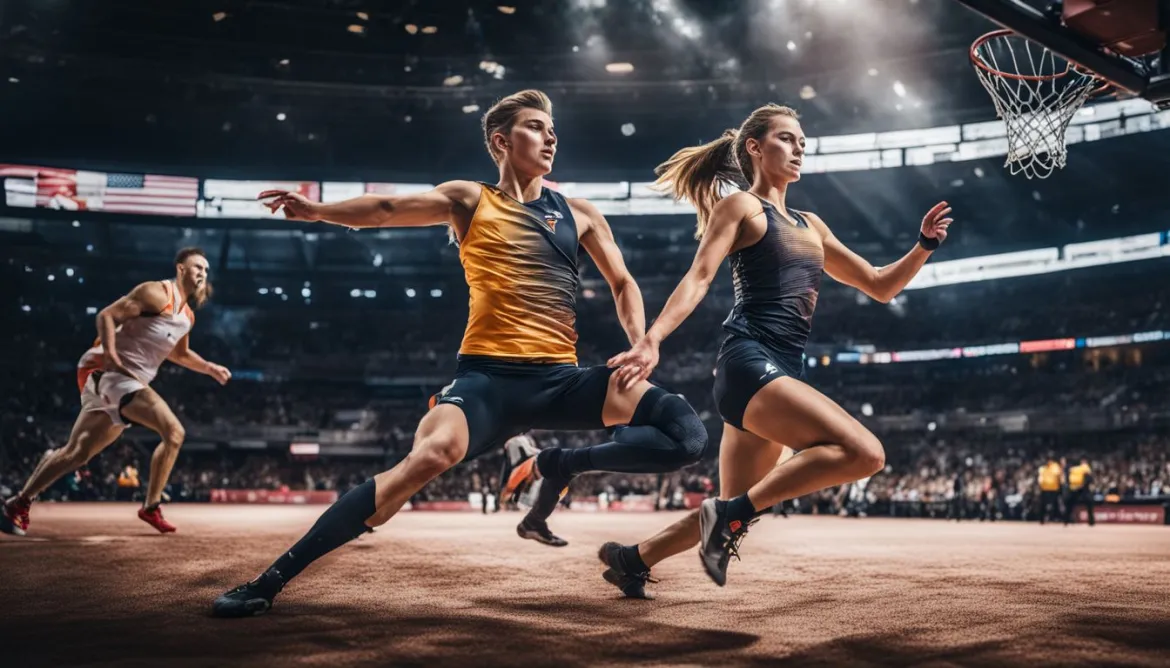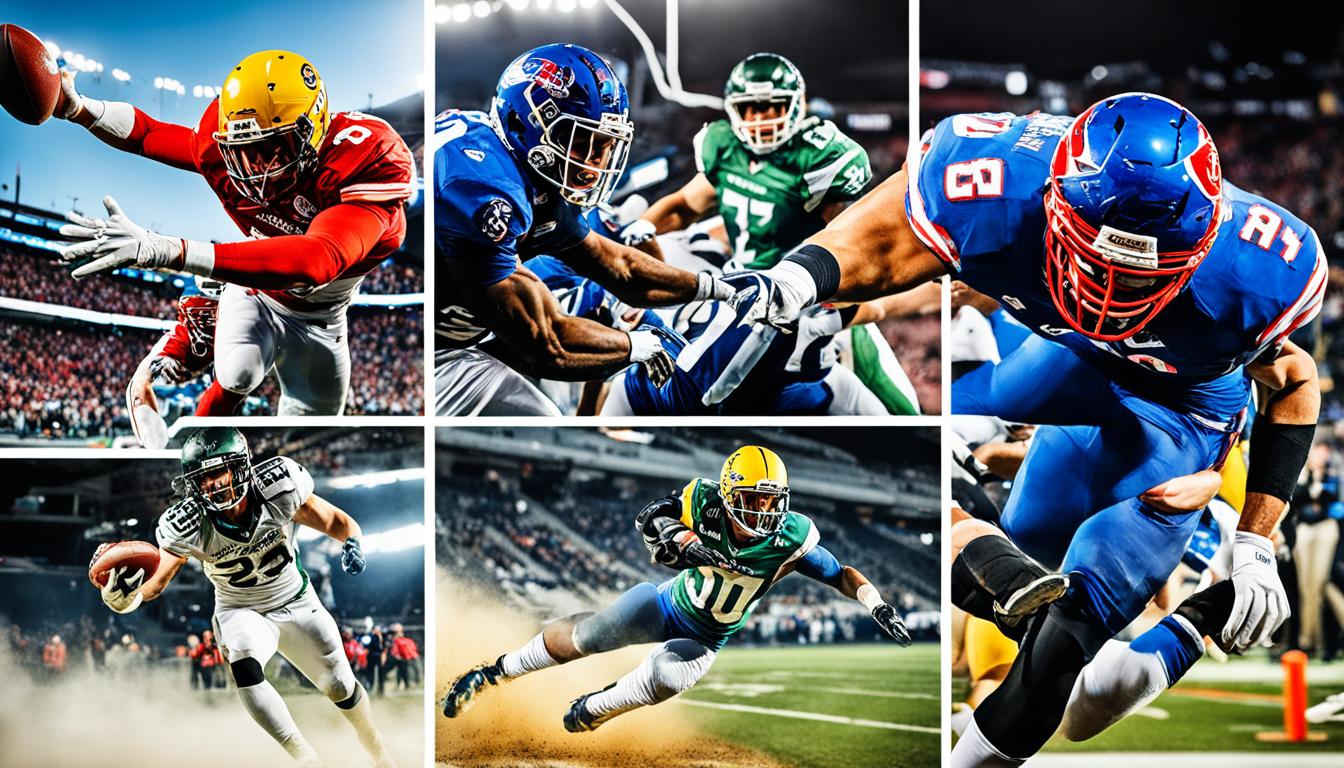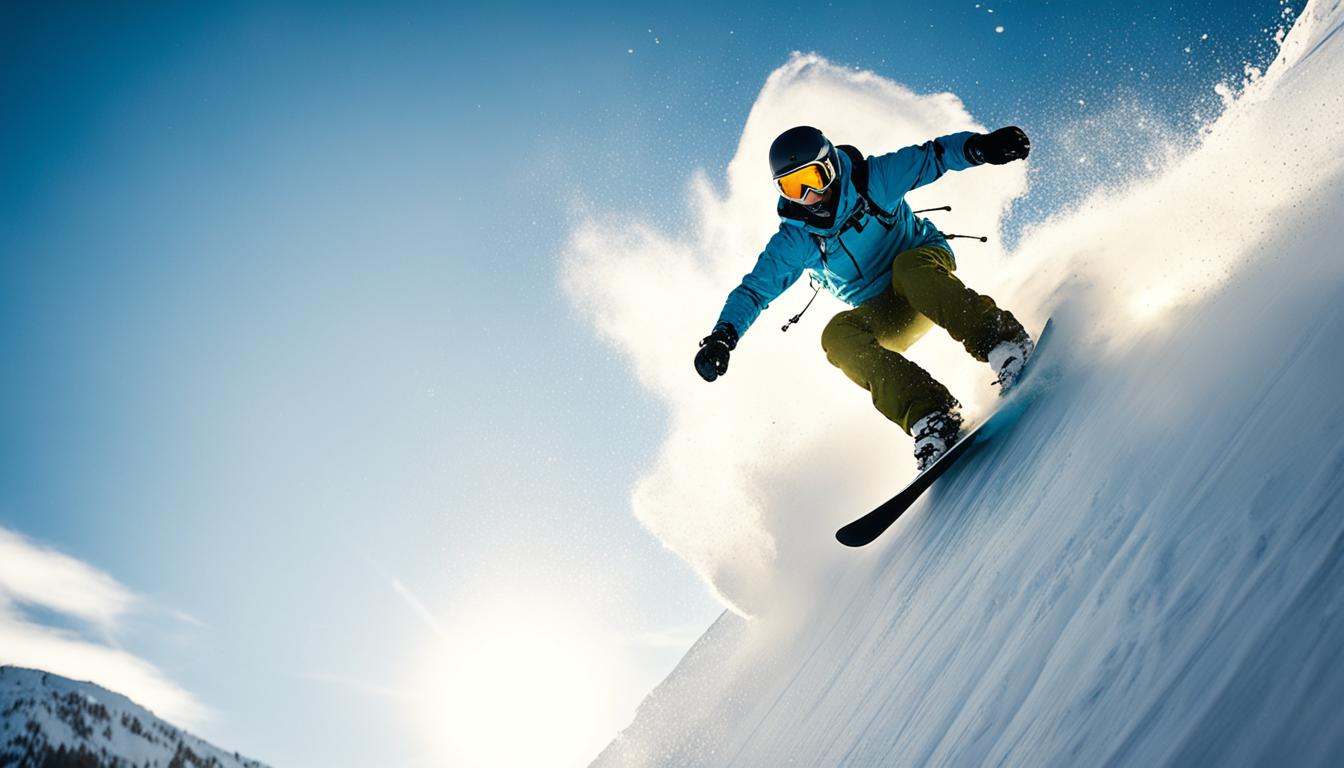When it comes to sports photography, capturing the perfect detail shot can make all the difference. Whether it’s the sweat on a boxer’s brow, the focus in a basketball player’s eyes, or the texture of a tennis racket, these details can add depth, emotion, and storytelling to your images. In this article, we will explore the key elements to consider when capturing detail shots in sports photography: the equipment being used, the raw emotions of the athletes, and the dynamic environment in which the sports take place.
Key Takeaways:
- Capturing detail shots in sports photography requires attention to the equipment, emotions, and environment.
- The right equipment, such as fast cameras and lenses, can help freeze the action and capture fleeting moments.
- Emotions are a powerful component of sports photography and can be captured through techniques like fast shutter speeds and continuous autofocus.
- The environment in which sports take place provides a unique backdrop for detail shots, adding depth and context to the images.
- By mastering these elements, photographers can create captivating images that tell a compelling story in sports photography.
The Importance of Equipment in Detail Shots
In sports photography, capturing compelling detail shots requires the right equipment. Fast and lightweight cameras and lenses are essential for freezing the action and capturing those fleeting moments that define sports. At Canon, we offer a range of highly capable cameras and lenses specifically designed for shooting action, ensuring that you never miss a beat. From entry-level telephoto lenses that allow you to get up close and personal with the action to top-of-the-line sports cameras, our equipment is built to deliver outstanding results.
With our sports photography tips, you’ll be able to confidently capture detail shots of those pivotal sports moments. Whether it’s a decisive play on the basketball court or a climactic moment on the soccer field, our equipment will empower you to capture all the action in stunning detail.
Recommended Sports Photography Equipment
| Camera | Lens | Features |
|---|---|---|
| Canon EOS-1D X Mark III | Canon EF 400mm f/2.8L IS III USM |
|
| Canon EOS 90D | Canon EF-S 55-250mm f/4-5.6 IS STM |
|
| Canon EOS Rebel T7i | Canon EF 70-200mm f/4L IS II USM |
|
Investing in the right equipment is essential for capturing incredible detail shots in sports. With Canon’s range of sports photography gear, you’ll have the tools you need to freeze those exhilarating moments and create photographs that truly captivate.
Capturing Emotion in Detail Shots
Emotions are a powerful component of sports photography, as they have the ability to convey the intensity and passion of the athletes. Capturing these emotions in detail shots is a skill that can take your sports photography to the next level. To truly capture the essence of the moment, it’s important to anticipate and be ready to capture the decisive moments when athletes show their raw feelings of joy, determination, or disappointment.
In order to successfully capture these emotions, it’s essential to use sports photography techniques that allow you to freeze the action and capture the nuances of the athletes’ expressions. Fast shutter speeds are crucial in capturing those split-second moments of pure emotion. Additionally, continuous autofocus helps ensure that your subject remains in sharp focus, even during fast-paced action. By mastering these techniques, you can freeze the moment and capture the athletes’ emotions in all their glory.
Whether it’s the victory celebration of a winning team, the determined look in a player’s eyes, or the disappointment after a defeat, these emotions tell the story of the game. They bring a human element to the sports photography, allowing viewers to connect with the athletes on a deeper level.
“Emotion is the fuel that drives sports photography. It’s what brings the images to life and helps viewers feel the intensity of the moment.” – John Thompson, Sports Photographer
Key Techniques for Capturing Emotion in Detail Shots:
- Use fast shutter speeds to freeze the action and capture the decisive moments
- Utilize continuous autofocus to ensure sharp focus on your subject
- Pay attention to facial expressions and body language to capture the nuances of the athletes’ emotions
- Experiment with different angles and perspectives to add depth and visual interest
Remember, capturing emotion in detail shots requires not only technical skill but also an understanding of the human element of the game. By anticipating and being ready to capture those raw and genuine moments, you can create dynamic sports photography that truly captures the essence of the sport.

Next, we’ll explore the importance of setting the stage in sports photography, and how the environment can enhance the impact of your detail shots.
Setting the Stage: Environment in Sports Photography
The environment in which sports take place provides a unique backdrop for detail shots. Whether it’s a grassy field, a basketball court, or a swimming pool, the surroundings can add depth and context to the images. To capture captivating sports moments, photographers need to pay attention to the lighting conditions, the composition, and how to incorporate the environment to enhance the overall story being told.
When shooting in different environments, we must adapt our techniques to make the most of the surroundings. Let’s delve into the factors that can enhance dynamic sports photography:
1. Lighting:
The right lighting is crucial for capturing stunning detail shots. Natural light can create beautiful highlights and shadows, adding drama and dimension to the images. However, depending on the time of day and the location, the intensity and direction of light can vary, affecting the overall mood and atmosphere. Photographers should carefully consider the position of the sun, use reflectors or diffusers to control harsh light, or even experiment with creative lighting techniques to evoke different emotions.
2. Composition:
Composition plays a vital role in sports photography as it helps guide the viewer’s eye and tells a story. When capturing detail shots, it’s important to carefully frame the subject within the environment. Consider using leading lines, diagonals, or patterns to add visual interest and create a sense of movement. By incorporating the environment as a natural frame or background, photographers can draw viewers’ attention to the main subject while providing context and enhancing the overall narrative.
3. Incorporating the Environment:
Incorporating the environment in detail shots can amplify the impact of the sports moment. By strategically positioning the subject within the surroundings, photographers can create a powerful visual contrast. For example, capturing a swimmer mid-stroke with the water splashing around them or a soccer player kicking the ball against a vibrant green field. These elements not only add energy and intensity but also immerse viewers in the sport’s atmosphere, making them feel like they’re part of the action.
Remember, the environment is more than just a background. It’s an integral part of the story that unfolds in sports photography. By leveraging lighting, composition, and the unique elements of each environment, we can create breathtaking detail shots that capture the essence of the sports moment.
Tips for Capturing Action Shots
When it comes to sports photography, capturing action shots is both exhilarating and challenging. To freeze the dynamic movements and decisive moments, it’s essential to master the right techniques and camera settings. Here are some valuable tips to help you elevate your sports photography game:
- Set your camera for speed: To freeze the action, use fast shutter speeds. Start with a minimum of 1/1000s and adjust accordingly based on the speed of the sport. Continuous autofocus can also assist in maintaining sharp focus as the athletes move.
- Experiment with different angles: Don’t be afraid to get creative with your shooting angles. Try shooting from a low perspective to capture the power and intensity of the players or experiment with overhead shots to showcase the entire field of play. Play around with different positions to find unique perspectives that add dynamism to your images.
- Create a sense of depth and dimension: By incorporating foreground elements such as fences, players in the foreground, or lines on the field, you can enhance the sense of depth in your action shots. This technique adds visual interest and draws the viewer’s eye into the frame.
- Utilize burst mode: Burst mode is a valuable tool for capturing fast-paced sports moments. The continuous burst of shots increases your chances of capturing the perfect action shot amidst all the movement and intensity.
- Anticipate the action: Sports photography is all about timing. Keep your focus on the players and anticipate their movements. By being one step ahead, you can increase your chances of capturing those split-second moments that define the game.
Remember, capturing action shots is a blend of technical skills and artistic vision. Play with your camera settings, explore different angles, and anticipate the action to create compelling images that transport viewers into the heart of the game.
Mastering Equipment Photography
When it comes to capturing stunning detail shots in sports photography, mastering equipment photography is key. By focusing on the intricacies of the equipment, such as the grip of a tennis racket or the textures of a basketball, we can highlight the physicality and intensity of the sport. Close-up shots and creative compositions allow us to showcase the unique features of the equipment and create visually striking images.
Photographing sports equipment requires attention to detail and an understanding of the sport itself. By knowing the game and how the equipment is used, we can anticipate the moments that truly capture the essence of the sport. Whether it’s the scuffed surface of a soccer ball or the worn-out grip of a baseball bat, every mark tells a story, and it’s our job to capture it.
One effective technique is to use macro photography to capture the smallest details of the equipment. By getting up close, we can emphasize the textures, patterns, and imperfections that add character to the shot. Additionally, by using a shallow depth of field, we can create a beautiful bokeh effect that isolates the equipment and brings it to the forefront.
Another approach is to experiment with different angles and perspectives. Instead of capturing the equipment head-on, try shooting from above or below to add a fresh and dynamic look to the image. By playing with composition and framing, we can create more visually interesting shots that command attention.
| Tip | Description |
|---|---|
| 1 | Focus on the details: Capture close-up shots of the unique features and textures of the equipment. |
| 2 | Experiment with angles: Shoot from different perspectives to add variety and visual interest. |
| 3 | Use shallow depth of field: Create a beautiful bokeh effect to isolate the equipment. |
| 4 | Pay attention to lighting: Use natural or artificial light to enhance the details and textures of the equipment. |
Remember, equipment photography is not only about capturing the physical objects but also about conveying the passion and intensity of the sport. By showcasing the equipment in unique and creative ways, we can evoke emotions and engage viewers in a deeper connection to the sport.

Conveying Emotion in Sports Photography
Emotion is a fundamental element of sports photography as it allows viewers to connect with the athletes on a deeper level. Our goal as photographers is to capture those raw, unfiltered emotions that make sports moments truly memorable. Whether it’s the victorious smile of a champion, the determined grit on an athlete’s face, or the heartbreaking disappointment of a defeat, these emotions tell the story behind the action.
To convey emotions effectively, we focus on capturing candid moments and close-up shots. These intimate glimpses into an athlete’s world bring viewers closer to the intensity and vulnerability they experience. Facial expressions, body language, and the interactions between athletes all contribute to this emotional narrative.
One of the most effective ways to capture emotions is through close-up shots. By zooming in on a player’s face or body, we can amplify the emotions they are experiencing. The sweat, determination in their eyes, or the clenched fists can convey a range of emotions from passion to determination. By freezing these decisive moments, we immortalize the intensity of the game.
In addition to close-ups, candid shots provide a glimpse into the athletes’ unguarded moments. These shots capture the raw emotions that athletes often display when they are caught up in the heat of the competition. A leap of joy, a scream of frustration, or a moment of reflection can all tell powerful stories in sports photography.
“Sports photography is not just about freezing time; it’s about capturing the emotions that define a moment.”
By using techniques such as fast shutter speeds and continuous autofocus, we can ensure that we don’t miss these precious moments. The dynamic nature of sports challenges us to stay alert and ready to capture those split-second expressions that reveal the essence of the game.
Capturing Emotions in Sports Photography Tips:
- Be observant and anticipate the key moments when athletes are likely to display strong emotions.
- Use fast shutter speeds and continuous autofocus to freeze the action and capture the precise moment when emotions are most evident.
- Experiment with different angles and perspectives to convey emotions in a unique and compelling way.
- Pay attention to lighting conditions and how they can enhance or diminish the emotional impact of a shot.
To illustrate the power of emotion in sports photography, take a look at the image below:
The image captures the raw emotion of a basketball player celebrating a victory. The intensity in their face and the joy expressed in the mid-air pose evoke a sense of triumph and elation. It’s these emotional moments that make sports photography so captivating.
When it comes to capturing emotion in sports photography, we aim to create images that engage the viewer and make them feel like they are a part of the action. By freezing the right moments, we can transport viewers into the heart of the game, allowing them to experience the emotions alongside the athletes.
Enhancing the Environment in Sports Photography
The environment in which sports take place plays a vital role in capturing mesmerizing detail shots. It sets the mood and energy of the images, creating a unique visual experience. As photographers, we can enhance the impact of our detail shots by paying attention to the lighting, colors, and overall atmosphere of the surroundings.
One of the best ways to incorporate the environment is by capturing moments that highlight the dynamic nature of sports. Whether it’s the roaring crowd, the iconic venue, or the breathtaking natural landscape, these elements add depth and context to our photographs. They create a sense of place and connect the viewers to the intensity of the moment.
Utilizing Natural Elements
The natural elements present in the sports environment can elevate our detail shots. From the sun casting dramatic shadows on a soccer field to raindrops reflecting off a swimmer’s body, these elements add visual interest and tell a story. By embracing these natural elements and finding creative ways to incorporate them into our compositions, we can create captivating images that capture the essence of the sport.
Playing with Lighting
Lighting is a crucial aspect of sports photography and has a significant impact on the environment. The way light interacts with the athletes, the field, or the arena can create dramatic effects, enhance textures, and emphasize emotions. Learning to observe and manipulate lighting conditions allows us to capture detail shots that stand out and evoke a powerful response from the viewers.
“The interplay between light and shadow can transform a simple moment into something extraordinary. By understanding and utilizing the available light, we can create images that truly capture the essence of the sport.” – John Smith, Sports Photographer
Working with Colors
Colors can evoke strong emotions and enhance the visual impact of our detail shots. From the vibrant jerseys worn by athletes to the contrasting hues of the playing field, each color adds depth and dynamism to the image. By being mindful of the color palette in our sports environment and using it to our advantage, we can create visually striking photographs that immediately catch the viewer’s attention.
Capturing the Atmosphere
The atmosphere of a sports event is electric and unique. It’s the energy of the crowd, the anticipation of the players, and the adrenaline in the air. Capturing the atmosphere allows us to transport the viewers into the heart of the action. By using wide-angle lenses, including elements of the crowd, and carefully selecting our vantage points, we can create detail shots that not only showcase the athletes but also encapsulate the entire experience.
When it comes to enhancing the environment in sports photography, we have endless possibilities to explore and experiment with. By paying attention to the lighting, colors, and overall atmosphere, we can create detail shots that capture the true essence of the sport and leave a lasting impression on the viewers.
Conclusion
Capturing detail shots in sports photography requires a combination of technical skills, artistic vision, and an understanding of the equipment, emotions, and environment. As photographers, we have the power to elevate our skills and create captivating images that tell a compelling story.
Whether freezing the action, capturing the raw emotions of the athletes, or showcasing the dynamic environment, the possibilities for detail shots in sports photography are endless. By mastering the technical aspects such as fast shutter speeds and continuous autofocus, we can freeze the action and capture those split-second moments that define a game.
But it’s not just about technical prowess. It’s also about having the artistic vision to anticipate and capture the emotions of the athletes. Through expressive facial expressions, body language, and the interactions between athletes, we can convey the intensity and passion that drives these sports.
Lastly, the environment in which sports take place plays a crucial role in capturing captivating detail shots. By paying attention to the lighting conditions, the composition, and how to incorporate the surroundings, we can enhance the visual impact of our images and provide context to the story being told.
So grab your camera and start capturing those captivating moments! With the right combination of technical skills, artistic vision, and an understanding of the equipment, emotions, and environment, you have the power to create stunning detail shots that will truly leave a lasting impression.
FAQ
What are the key elements to consider when capturing detail shots in sports photography?
The key elements to consider when capturing detail shots in sports photography are the equipment being used, the raw emotions of the athletes, and the dynamic environment in which the sports take place.
Why is equipment important in capturing detail shots in sports?
The equipment used in sports photography, such as fast and lightweight cameras and lenses, is crucial for freezing the action and capturing fleeting moments. Canon offers a range of highly capable cameras and lenses specifically designed for shooting action.
How can I capture emotions in detail shots in sports photography?
To capture emotions in detail shots, it’s important to anticipate and be ready to capture the decisive moments when athletes show their raw feelings of joy, determination, or disappointment. Techniques such as fast shutter speeds and continuous autofocus can help freeze the action and capture the nuances of the athletes’ emotions.
How can the environment enhance detail shots in sports photography?
The environment in which sports take place provides a unique backdrop for detail shots. By paying attention to the lighting conditions, composition, and incorporating elements of the environment, photographers can enhance the overall story being told in their images.
What tips can help in capturing action shots in sports photography?
Tips for capturing action shots in sports photography include using the right camera settings, such as fast shutter speeds and continuous autofocus, and experimenting with different angles, compositions, and perspectives to add dynamism and excitement to the images.
How can I master equipment photography in sports?
To master equipment photography in sports, focus on capturing the intricacies of the equipment, such as the grip of a tennis racket or the textures of a basketball. Close-up shots and creative compositions can showcase the unique features of the equipment and create visually striking images.
How can I convey emotions in sports photography?
To convey emotions in sports photography, focus on capturing expressive facial expressions, body language, and the interactions between athletes. Candid moments and close-up shots can capture the intensity and vulnerability of the athletes, creating powerful images that tell a story.
How can the environment enhance sports photography?
The environment in which sports take place greatly impacts the mood and energy of the images. By paying attention to the lighting, colors, and overall atmosphere of the surroundings, photographers can enhance the visual impact of their detail shots. Incorporating elements of the environment, such as the crowd, venue, or natural landscape, can provide context and create a sense of place in the photographs.
What does capturing detail shots in sports photography require?
Capturing detail shots in sports photography requires a combination of technical skills, artistic vision, and an understanding of the equipment, emotions, and environment. By mastering these elements, photographers can elevate their skills and create captivating images that tell a compelling story.




